CHAGALL: Fantasies for the Stage
July 31, 2017 – January 7, 2018
LACMA. Los Angeles County Museum of Art
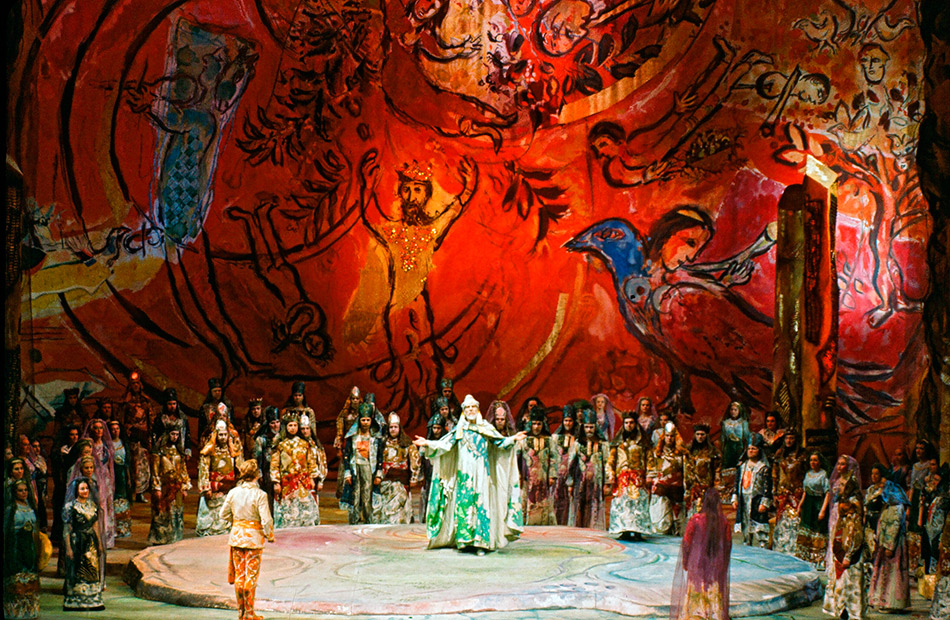 Marc Chagall, “The Magic Flute”, February 1967, Metropolitan Opera, New York, © 2017 Artists Rights Society (ARS), New York/ADAGP, Paris, photo: Frank Dunand/Metropolitan Opera Archives
Marc Chagall, “The Magic Flute”, February 1967, Metropolitan Opera, New York, © 2017 Artists Rights Society (ARS), New York/ADAGP, Paris, photo: Frank Dunand/Metropolitan Opera Archives
The first U.S. exhibition to spotlight the principal role that music and dance
played in Marc Chagall’s artistic career.
Concentrated in four theatrical productions created over a quarter century: Aleko (1942), The Firebird (1945) , Daphnis and Chloe (1959), and The Magic Flute (1967). The exhibition comprises 145 objects, including 41 vibrant costumes; nearly 100 preparatory sketches; rare 1942 film footage of the original performance of Aleko; musical accompaniments for each section; and a selection of paintings depicting musicians and theatrical scenes.
Exhibition Highlights
ALEKO
The exhibition opens with 11 costumes and 18 preparatory studies
from Chagall’s production of Aleko, from 1942
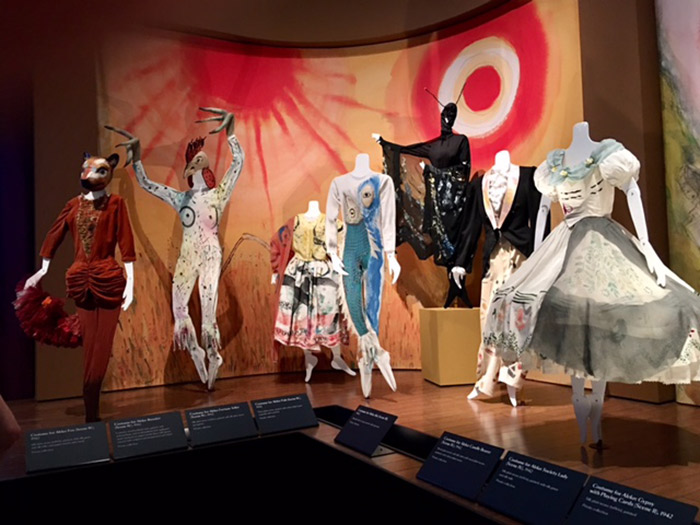 Installation photograph, “Chagall: Fantasies for the Stage,” from “Aleko,” Los Angeles County Museum of Art, © 2017 Artists Rights Society (ARS), New York / ADAGP, Paris, photo © Fredrik Nilsen.
Installation photograph, “Chagall: Fantasies for the Stage,” from “Aleko,” Los Angeles County Museum of Art, © 2017 Artists Rights Society (ARS), New York / ADAGP, Paris, photo © Fredrik Nilsen.
Chagall and his family, who were Jewish, emigrated to New York in 1941 fleeing persecution from Nazi-occupied France. The following year, the Ballet Theatre of New York (now the American Ballet Theatre) commissioned him to design the scenery and costumes for Aleko, a new ballet based on an 1824 poem by Alexander Pushkin and set to Pyotr Tchaikovsky’s Trio in A Minor.
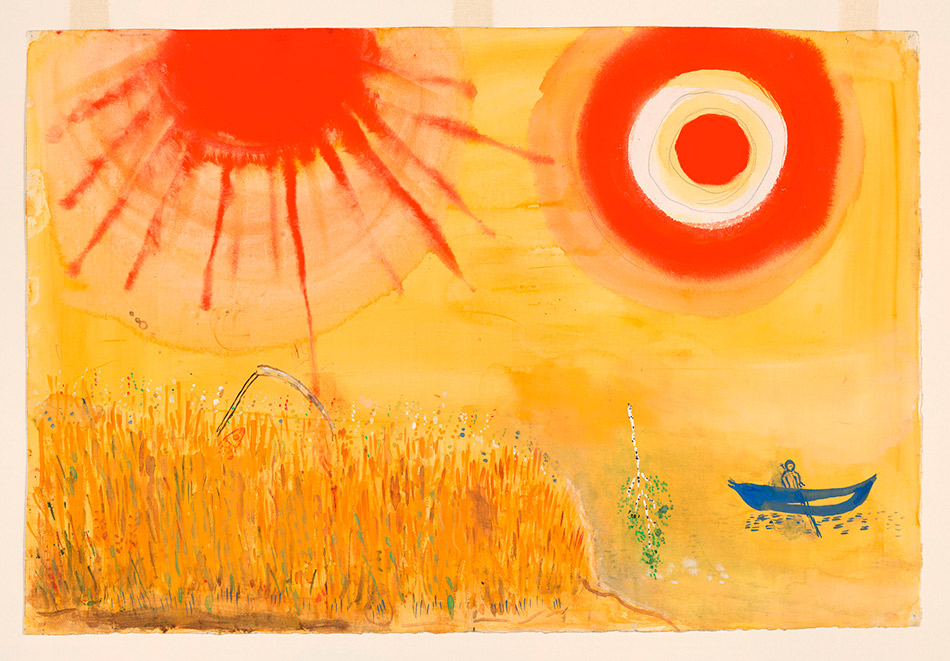 Marc Chagall, Study for Backdrop for Aleko: A Wheatfield on a Summer’s Afternoon (Scene III), 1942, gouache, watercolor, and graphite on paper, 15 1/4 × 22 1/2 in., Museum of Modern Art, New York, acquired through the Lillie P. Bliss Bequest, 1945, © 2017 Artists Rights Society (ARS), New York/ADAGP, Paris, digital image © 2017 The Museum of Modern Art/licensed by SCALA/Art Resource, NY
Marc Chagall, Study for Backdrop for Aleko: A Wheatfield on a Summer’s Afternoon (Scene III), 1942, gouache, watercolor, and graphite on paper, 15 1/4 × 22 1/2 in., Museum of Modern Art, New York, acquired through the Lillie P. Bliss Bequest, 1945, © 2017 Artists Rights Society (ARS), New York/ADAGP, Paris, digital image © 2017 The Museum of Modern Art/licensed by SCALA/Art Resource, NY
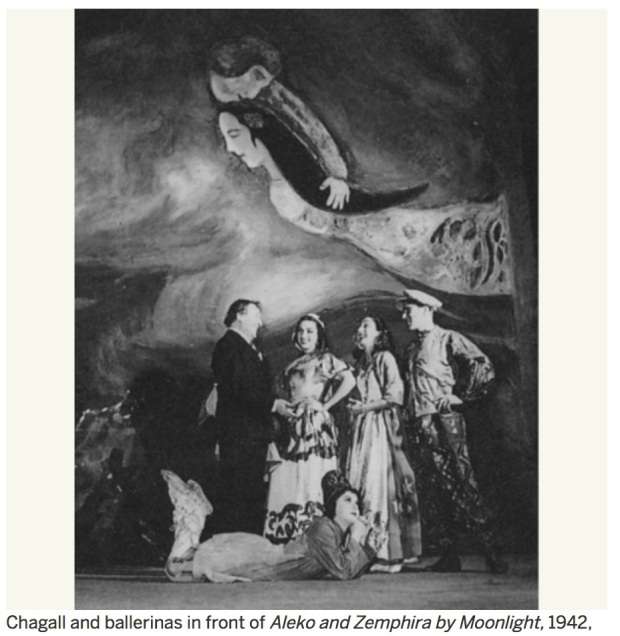
The ballet was choreographed by Léonide Massine, a fellow émigré and former member of the Ballets Russes, with famed dancers Alicia Markova and George Skibine dancing the lead roles.
Chagall’s work premiered at the Palacio de Bellas Artes in Mexico City on September 8, 1942, before opening at the Metropolitan Opera House in New York a month later. Chagall came to Los Angeles in the summer of 1943, when the ballet was performed at the Hollywood Bowl. Aleko was meant to debut in New York, but union rules would have prevented Chagall from painting the backdrops himself, so he and the Ballet Theatre completed work on the production in Mexico. Chagall hand-painted the Aleko costumes and backdrops and they have retained their vivid colors more than 70 years later.
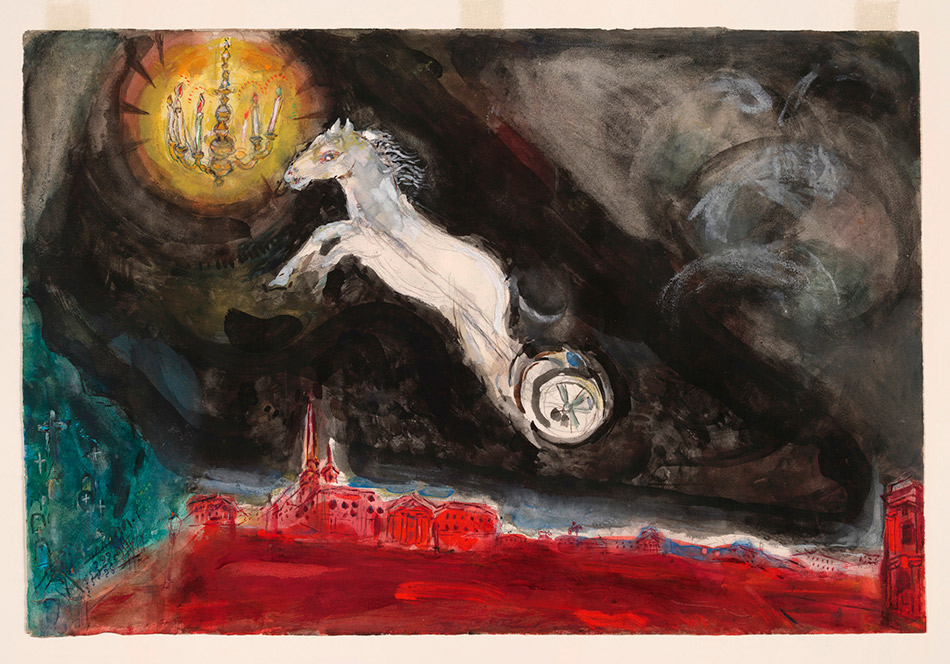 Marc Chagall, Study for Backdrop for Aleko: A Fantasy of St. Petersburg (Scene IV), 1942, gouache, watercolor, and graphite on paper, 15 × 22 3/8 in., Museum of Modern Art, New York, acquired through the Lillie P. Bliss Bequest, 1945, © 2017 Artists Rights Society (ARS), New York/ADAGP, Paris, digital image © 2017 The Museum of Modern Art/licensed by SCALA/Art Resource, NY
Marc Chagall, Study for Backdrop for Aleko: A Fantasy of St. Petersburg (Scene IV), 1942, gouache, watercolor, and graphite on paper, 15 × 22 3/8 in., Museum of Modern Art, New York, acquired through the Lillie P. Bliss Bequest, 1945, © 2017 Artists Rights Society (ARS), New York/ADAGP, Paris, digital image © 2017 The Museum of Modern Art/licensed by SCALA/Art Resource, NY
The costumes for the characters Zemphira, the Fortune Teller, and a Candle Bearer show that Chagall drew inspiration from Mexican styles of dress and traditional textile motifs, as well as from the music, folklore, and poetry of his native Russia. His use of abstract shapes and patterns also testifies to the modernist influence of artists such as Henri Matisse, whose work Chagall had encountered in New York.
THE FIREBIRD
This section of the exhibition presents eight costumes and 32 works on paper
 Installation photograph, “Chagall: Fantasies for the Stage,” from “The Firebird,” © 2017 Artists Rights Society (ARS), New York / ADAGP, Paris, photo © Fredrik Nilsen
Installation photograph, “Chagall: Fantasies for the Stage,” from “The Firebird,” © 2017 Artists Rights Society (ARS), New York / ADAGP, Paris, photo © Fredrik Nilsen
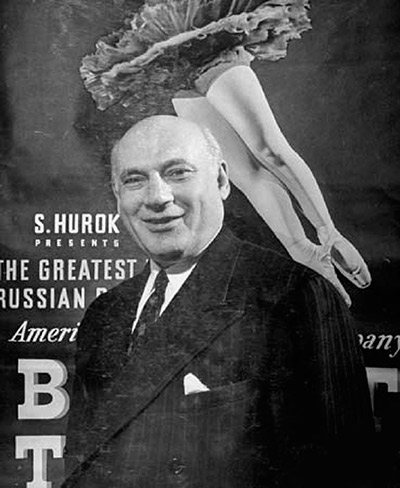 In 1945, Chagall received his second commission from the Ballet Theatre when the performing arts impresario Sol Hurok decided to restage Igor Stravinsky’s iconic ballet , which had premiered in Paris in 1910 at the Ballets Russes.
In 1945, Chagall received his second commission from the Ballet Theatre when the performing arts impresario Sol Hurok decided to restage Igor Stravinsky’s iconic ballet , which had premiered in Paris in 1910 at the Ballets Russes.
Chagall re-envisioned the stage curtain, sets, and costumes for the ballet, which debuted at the Metropolitan Opera House in New York on October 24, 1945. Chagall’s designs were met with great critical acclaim, and his production of “The Firebird” is still performed today, appearing as recently as the 2016 season of the New York City Ballet.
Chagall’s beloved wife Bella had died the year before Hurok approached the artist to design the ballet. In a profound state of grief, Chagall had ceased making art. His work on “The Firebird” marked both his reengagement with the art world and the beginning of a new phase in his scenography.
The more than 80 costumes Chagall made for the ballet were his most experimental and avant-garde to date, particularly those for the fantastical animals and monsters that abound in the ballet’s narrative. Working with his daughter, Ida, Chagall employed new materials and fabrication techniques, including a combination of diaphanous and heavy, richly colored fabrics, collage-like appliqués, and intricate embroidery that resulted in voluminous, sculptural forms. Photo: Sol Hurok.
 Marc Chagall, Costume Design for “The Firebird: Green Monster”, 1945, watercolor, gouache, and india ink on paper, 17 × 14 in., private collection, © 2017 Artists Rights Society (ARS), New York/ADAGP, Paris, photo © 2017 Archives Marc et Ida Chagall, Paris
Marc Chagall, Costume Design for “The Firebird: Green Monster”, 1945, watercolor, gouache, and india ink on paper, 17 × 14 in., private collection, © 2017 Artists Rights Society (ARS), New York/ADAGP, Paris, photo © 2017 Archives Marc et Ida Chagall, Paris
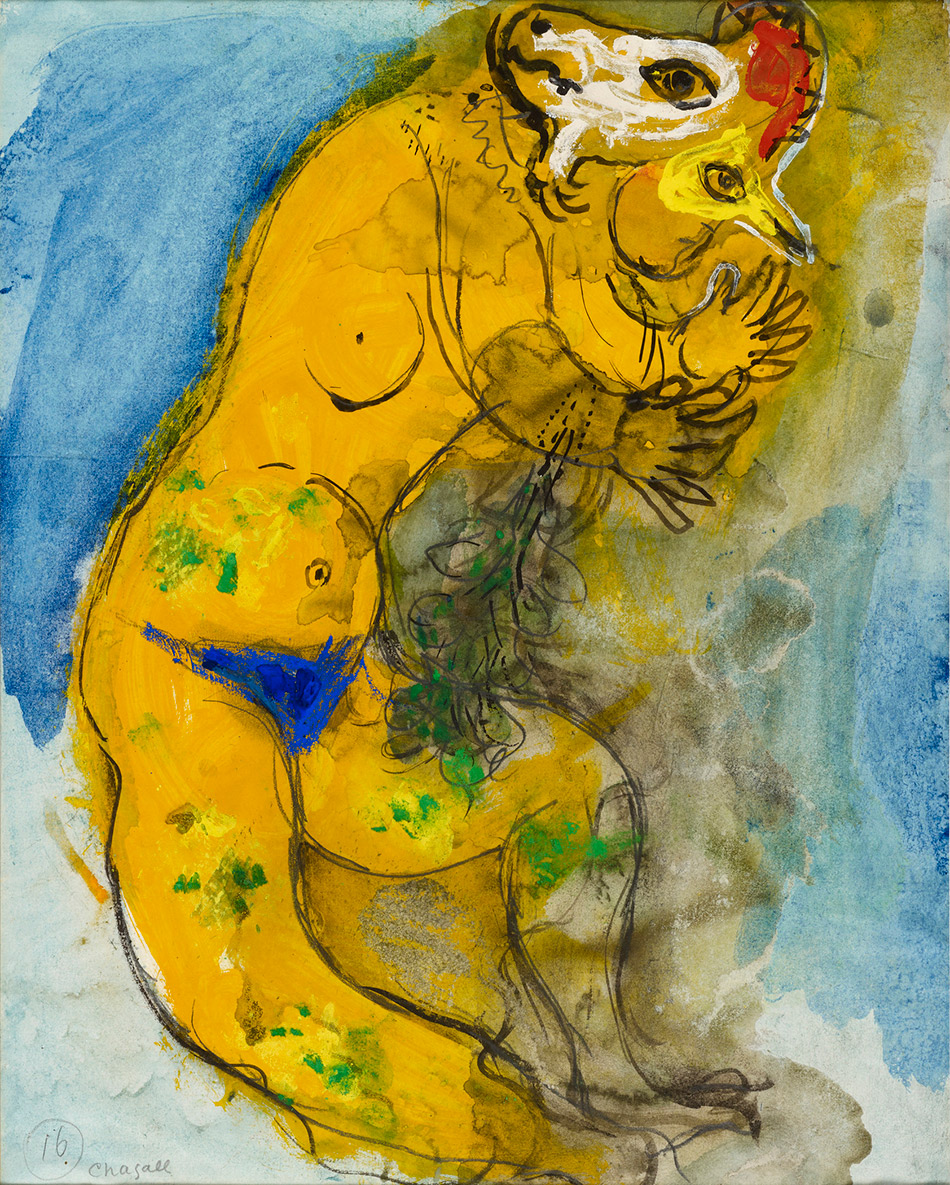
Marc Chagall, Costume Design for “The Firebird: Yellow Monster with Double Profile”, 1945, india ink, watercolor, graphite, and gouache on paper, 16 5/8 × 13 3/8 in., private collection, © 2017 Artists Rights Society (ARS), New York/ADAGP, Paris, photo © 2017 Archives Marc et Ida Chagall, Paris
 Marc Chagall, Costume Design for “The Firebird: Blue-and-Yellow Monster from Koschei’s Palace Guard”, 1945, watercolor, gouache, graphite, and india ink on paper, 18 5/16 × 11 7/16 in., private collection, © 2017 Artists Rights Society (ARS), New York/ADAGP, Paris, photo © 2017 Archives Marc et Ida Chagall, Paris
Marc Chagall, Costume Design for “The Firebird: Blue-and-Yellow Monster from Koschei’s Palace Guard”, 1945, watercolor, gouache, graphite, and india ink on paper, 18 5/16 × 11 7/16 in., private collection, © 2017 Artists Rights Society (ARS), New York/ADAGP, Paris, photo © 2017 Archives Marc et Ida Chagall, Paris
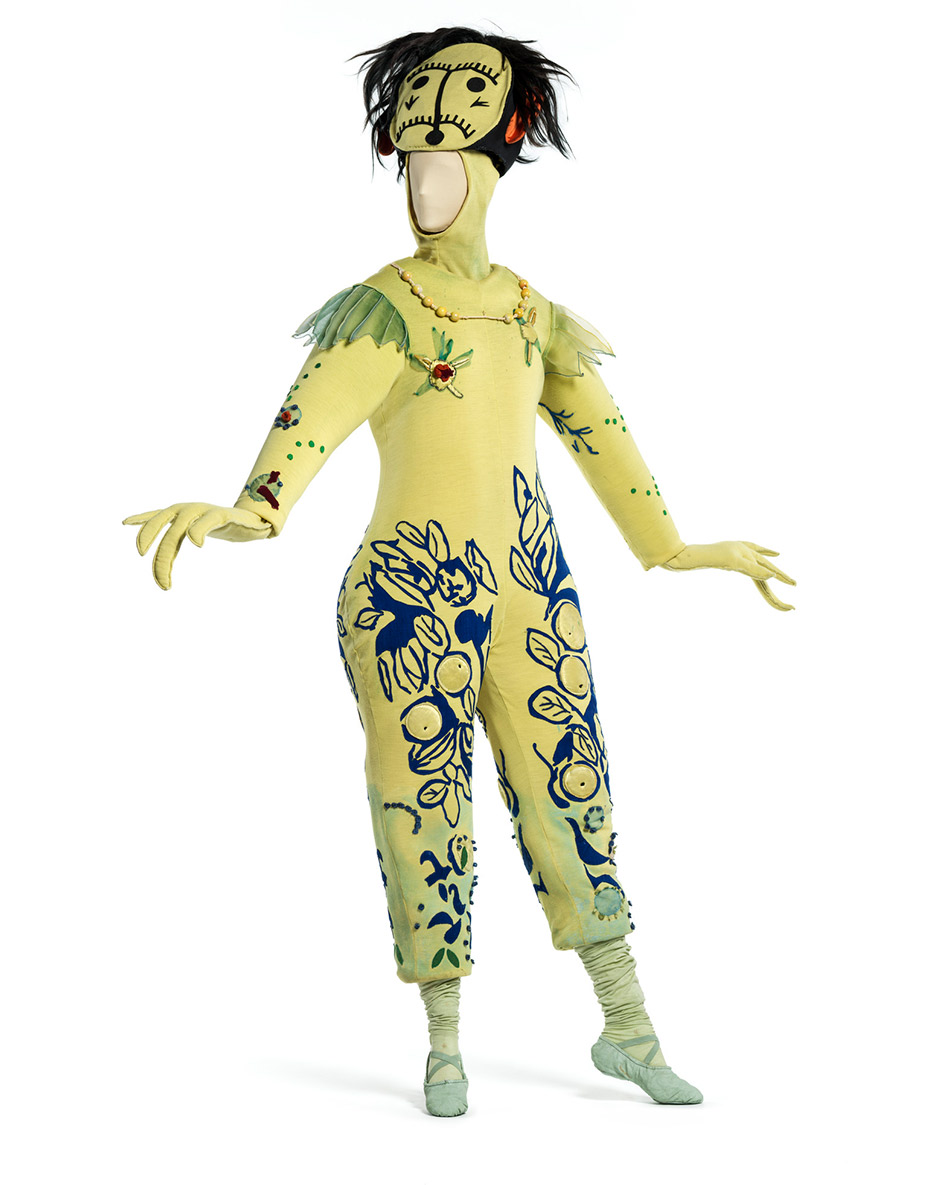
Marc Chagall, Costume for “The Firebird: Blue-and-Yellow Monster from Koschei’s Palace Guard”, 1945, wool/synthetic knit with polyurethane, wool/synthetic knit appliqués, wood beads, silk plain weave (chiffon), and animal hair, New York City Ballet, New York, © 2017 Artists Rights Society (ARS), New York/ADAGP, Paris, photo © 2017 Museum Associates/LACMA
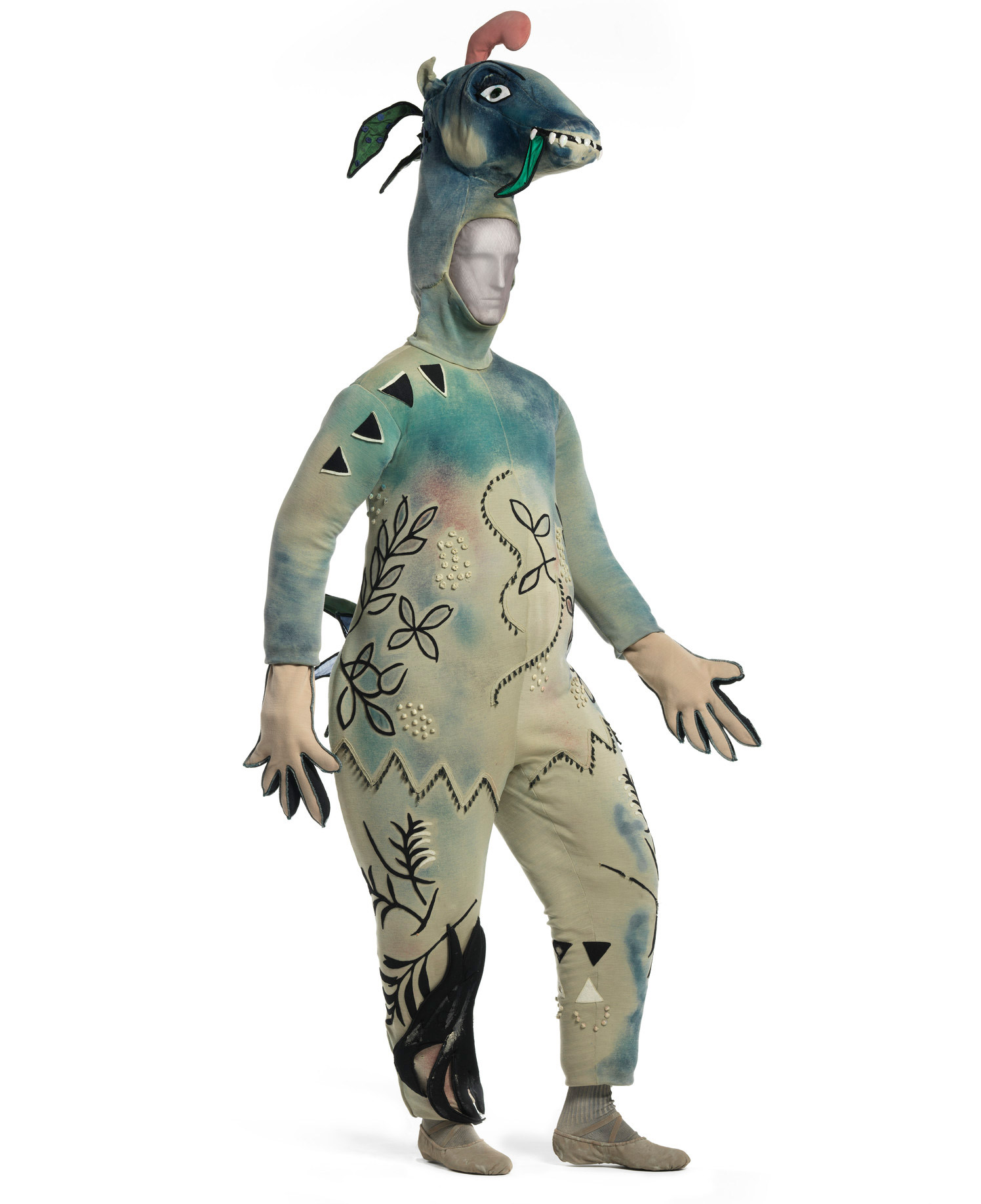 Marc Chagall, Costume for “The Firebird: Monster with Donkey’s Head”, 1945, wool/synthetic knit, painted, with polyurethane and wool/synthetic knit appliqués, New York City Ballet, New York, © 2017 Artists Rights Society (ARS), New York/ADAGP, Paris, photo © 2017 Museum Associates/LACMA
Marc Chagall, Costume for “The Firebird: Monster with Donkey’s Head”, 1945, wool/synthetic knit, painted, with polyurethane and wool/synthetic knit appliqués, New York City Ballet, New York, © 2017 Artists Rights Society (ARS), New York/ADAGP, Paris, photo © 2017 Museum Associates/LACMA
DAPHNIS AND CHLOE
The artist’s work on this ballet is represented by eight costumes and 28 drawings
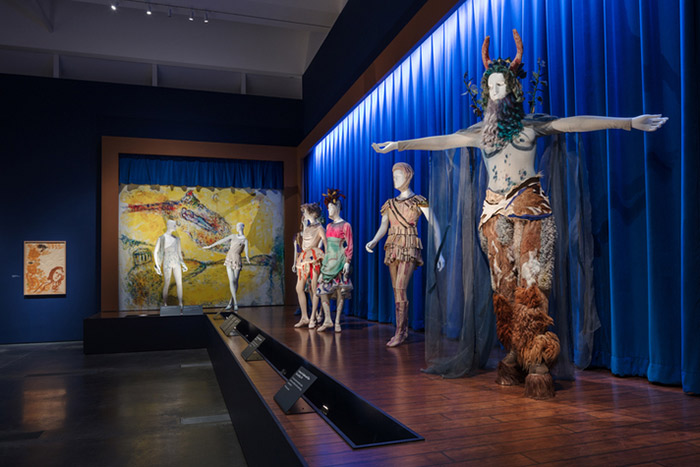 Installation photograph, “Chagall: Fantasies for the Stage,” from “Daphnis and Chloe,” Los Angeles County Museum of Art, July 31, 2017–January 7, 2018, © 2017 Artists Rights Society (ARS), New York / ADAGP, Paris, photo © Fredrik Nilsen.
Installation photograph, “Chagall: Fantasies for the Stage,” from “Daphnis and Chloe,” Los Angeles County Museum of Art, July 31, 2017–January 7, 2018, © 2017 Artists Rights Society (ARS), New York / ADAGP, Paris, photo © Fredrik Nilsen.
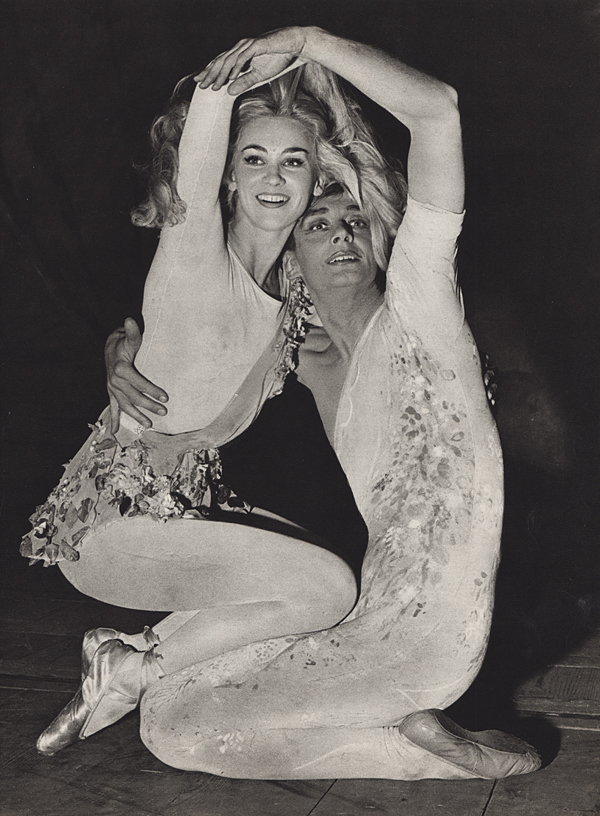 Eight years after Chagall returned to Paris in 1948, the Ballet de l’Opéra de Paris commissioned him to design new sets and costumes for Maurice Ravel’s ballet, which was based on a story attributed to the second-century Greek poet Longus. The motifs and color palette of blues and earthy ochers of Chagall’s stage designs were inspired by two trips he took to Greece, which is the setting for the ballet’s narrative. Chagall’s production of “Daphnis and Chloe” was choreographed by George Skibine (who also danced the role of Daphnis) and premiered at the Paris Opera in May 1959.
Eight years after Chagall returned to Paris in 1948, the Ballet de l’Opéra de Paris commissioned him to design new sets and costumes for Maurice Ravel’s ballet, which was based on a story attributed to the second-century Greek poet Longus. The motifs and color palette of blues and earthy ochers of Chagall’s stage designs were inspired by two trips he took to Greece, which is the setting for the ballet’s narrative. Chagall’s production of “Daphnis and Chloe” was choreographed by George Skibine (who also danced the role of Daphnis) and premiered at the Paris Opera in May 1959.
Chagall worked closely with Skibine and the other Ballet de l’Opéra de Paris dancers to harmonize his costumes with their movements and gestures.
His designs incorporated shimmering layered appliqués on sheer fabric, and he painted bold swaths of color onto the costumes while the dancers were wearing them in order to emphasize the fluid lines and dynamism of the dance. Chagall envisioned the dancers as mobile elements of his paintings, mirroring the figures he depicted in flight across his backdrops. Photo: the dancers Claude Bessy an George Skibine dresses with Chagall’s designs. May 1959
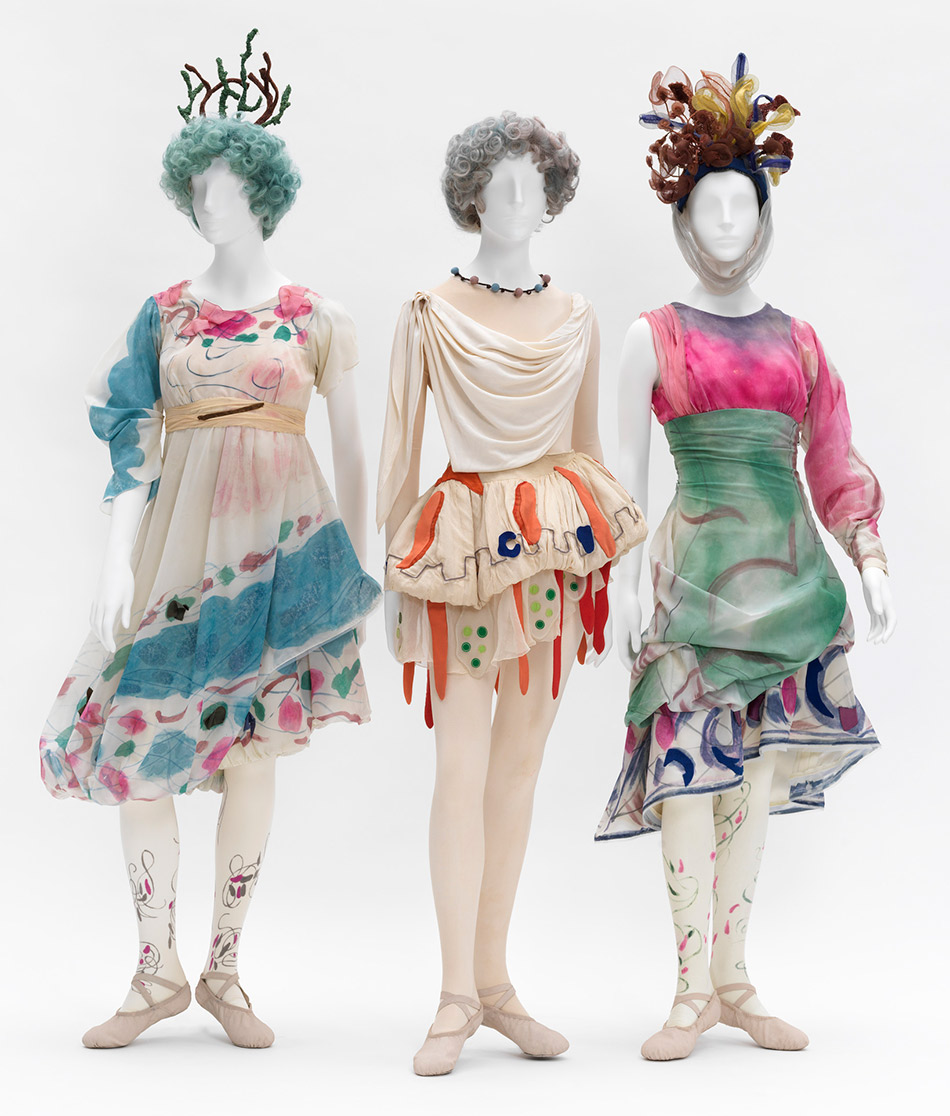 Marc Chagall, Costumes for “Daphnis and Chloe: Shepherdesses”, 1959, Paris, Opéra national, © 2017 Artists Rights Society (ARS), New York/ADAGP, Paris, photo © 2017 Museum Associates/LACMA
Marc Chagall, Costumes for “Daphnis and Chloe: Shepherdesses”, 1959, Paris, Opéra national, © 2017 Artists Rights Society (ARS), New York/ADAGP, Paris, photo © 2017 Museum Associates/LACMA
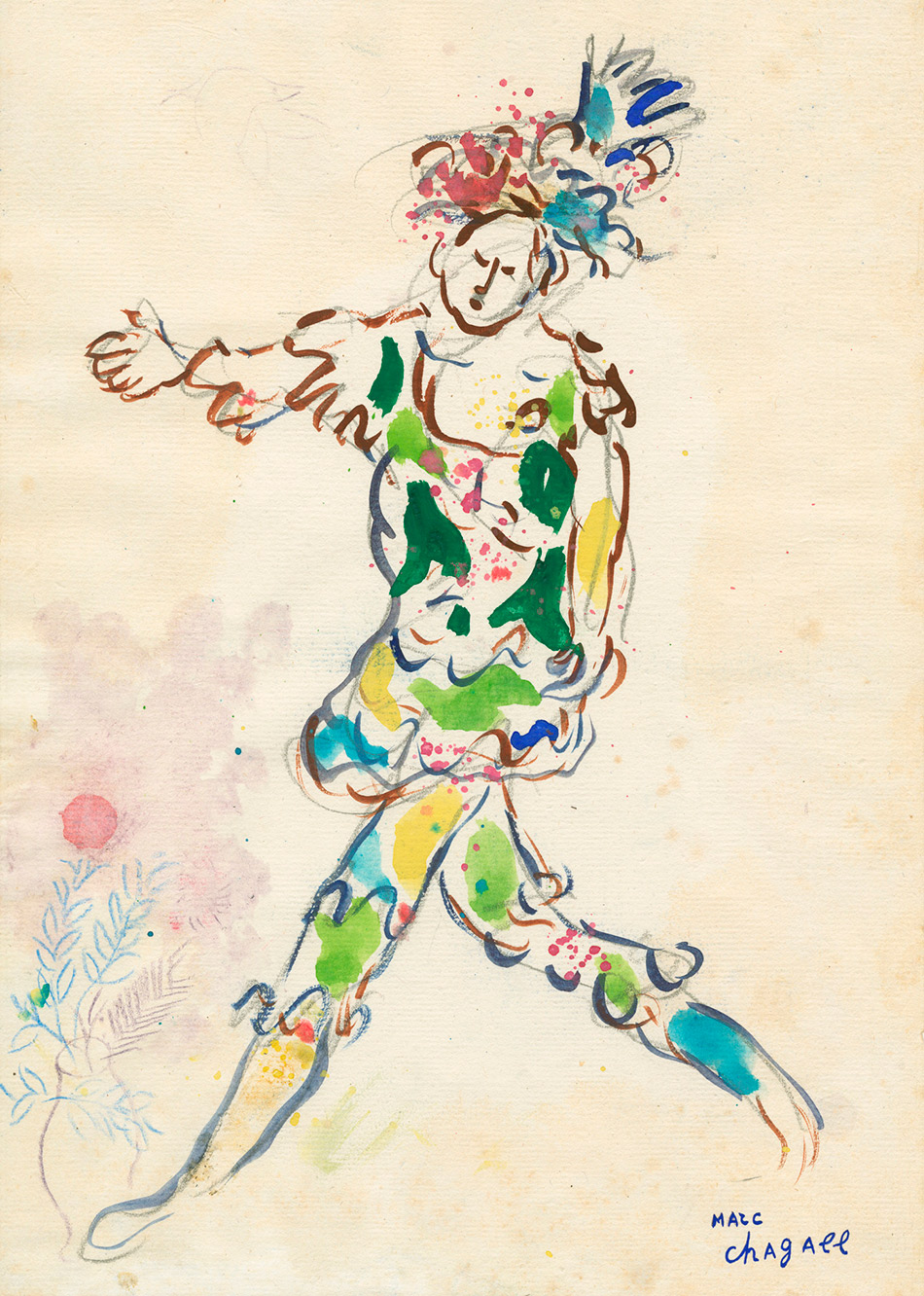 Marc Chagall, Costume Design for “Daphnis and Chloe: Young Man”, 1958, gouache, watercolor, graphite, and paper collage on paper, 13 3/8 × 9 3/8 in., private collection, © 2017 Artists Rights Society (ARS), New York/ADAGP, Paris, photo © 2017 Archives Marc et Ida Chagall, Paris
Marc Chagall, Costume Design for “Daphnis and Chloe: Young Man”, 1958, gouache, watercolor, graphite, and paper collage on paper, 13 3/8 × 9 3/8 in., private collection, © 2017 Artists Rights Society (ARS), New York/ADAGP, Paris, photo © 2017 Archives Marc et Ida Chagall, Paris
THE MAGIC FLUTE
Features 14 costumes and 16 sketches from Chagall’s production
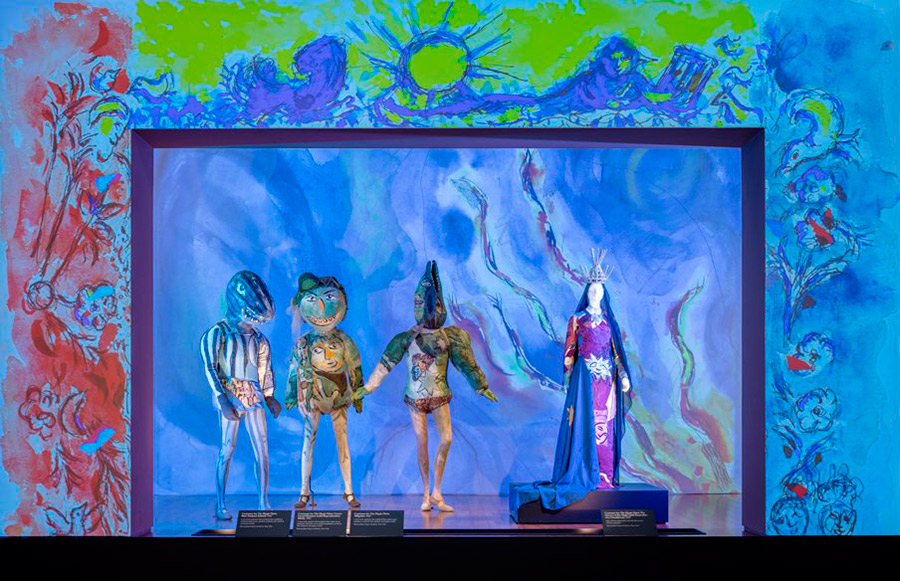 Installation photograph (detail), “Chagall: Fantasies for the Stage,” from “The Magic Flute,” © 2017 Artists Rights Society (ARS), New York / ADAGP, Paris, photo © Fredrik Nilsen.
Installation photograph (detail), “Chagall: Fantasies for the Stage,” from “The Magic Flute,” © 2017 Artists Rights Society (ARS), New York / ADAGP, Paris, photo © Fredrik Nilsen.
Commissioned by the Metropolitan Opera House for its inaugural season at Lincoln Center in New York in February 1967. Widely praised, this was Chagall’s only work for opera, and he spent three years designing the 14 sets and dozens of costumes.
Challenged by the complexity of the opera’s numerous scene changes, stage machinery, and the large number of singers, Chagall conceived aesthetic solutions that emphasized strong color contrasts and striking geometric forms to construct scenic space and communicate “The Magic Flute’s” dramatic narrative. Whimsical and highly imaginative animals similar to those Chagall created for “Aleko” and “The Firebird”—and that populate paintings throughout his oeuvre—played an important role in the artist’s production of “The Magic Flute”. He sculpted each costume by layering richly dyed textiles with colorful fabrics and embroidered lines to emphasize movement.
 Marc Chagall, Variation on the Theme of “The Magic Flute: Sarastro”, 1965, gouache on paper, 24 3/16 × 19 7/8 in., private collection, © 2017 Artists Rights Society (ARS), New York/ADAGP, Paris, photo © 2017 Archives Marc et Ida Chagall, Paris
Marc Chagall, Variation on the Theme of “The Magic Flute: Sarastro”, 1965, gouache on paper, 24 3/16 × 19 7/8 in., private collection, © 2017 Artists Rights Society (ARS), New York/ADAGP, Paris, photo © 2017 Archives Marc et Ida Chagall, Paris
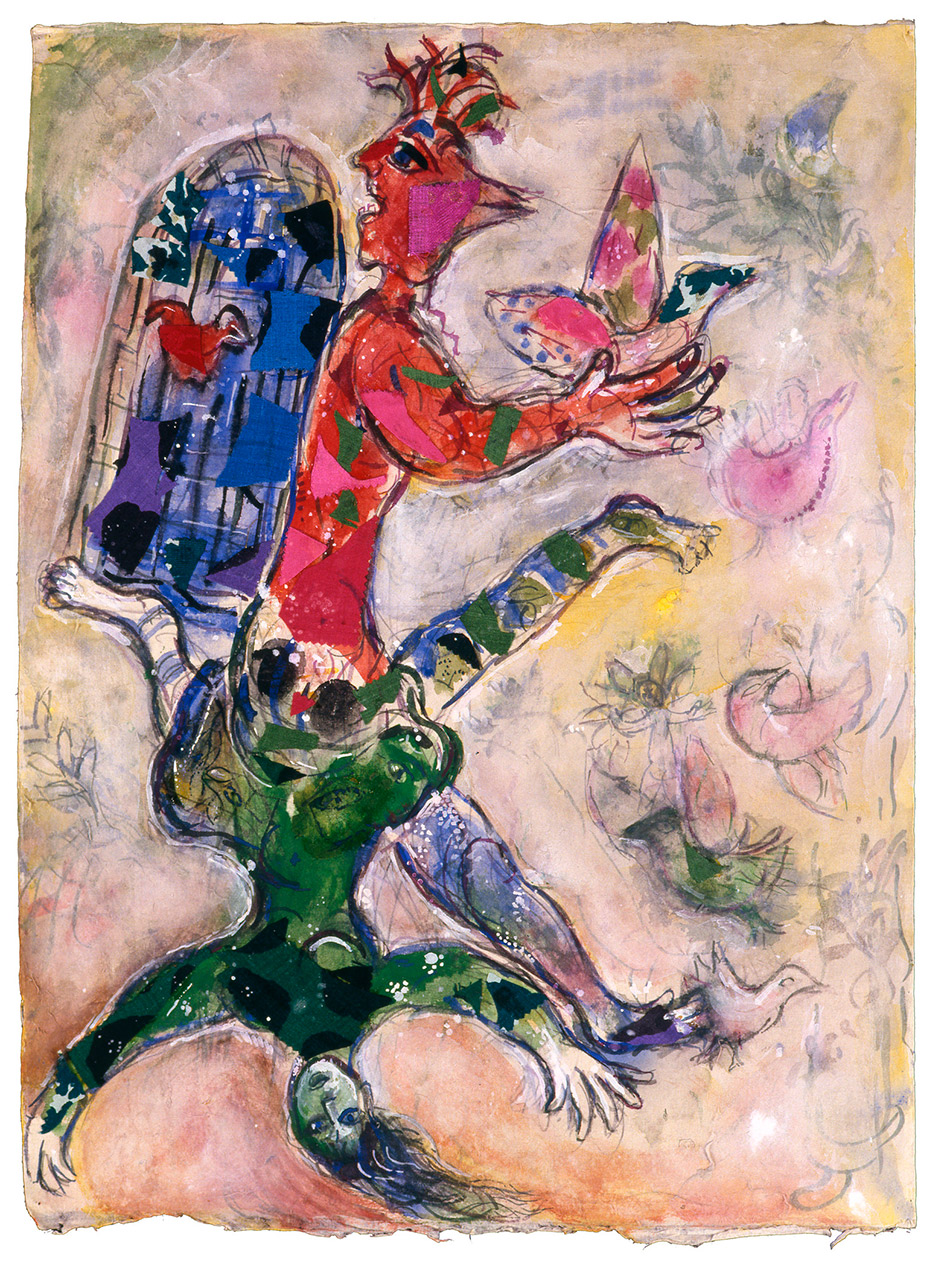 Marc Chagall, Variation on the Theme of “The Magic Flute: Papageno”, 1966–67, watercolor, gouache, ink, and fabric collage on Japan paper, 24 3/16 × 17 11/16 in., private collection, © 2017 Artists Rights Society (ARS), New York/ADAGP, Paris, photo © 2017 Archives Marc et Ida Chagall, Paris
Marc Chagall, Variation on the Theme of “The Magic Flute: Papageno”, 1966–67, watercolor, gouache, ink, and fabric collage on Japan paper, 24 3/16 × 17 11/16 in., private collection, © 2017 Artists Rights Society (ARS), New York/ADAGP, Paris, photo © 2017 Archives Marc et Ida Chagall, Paris
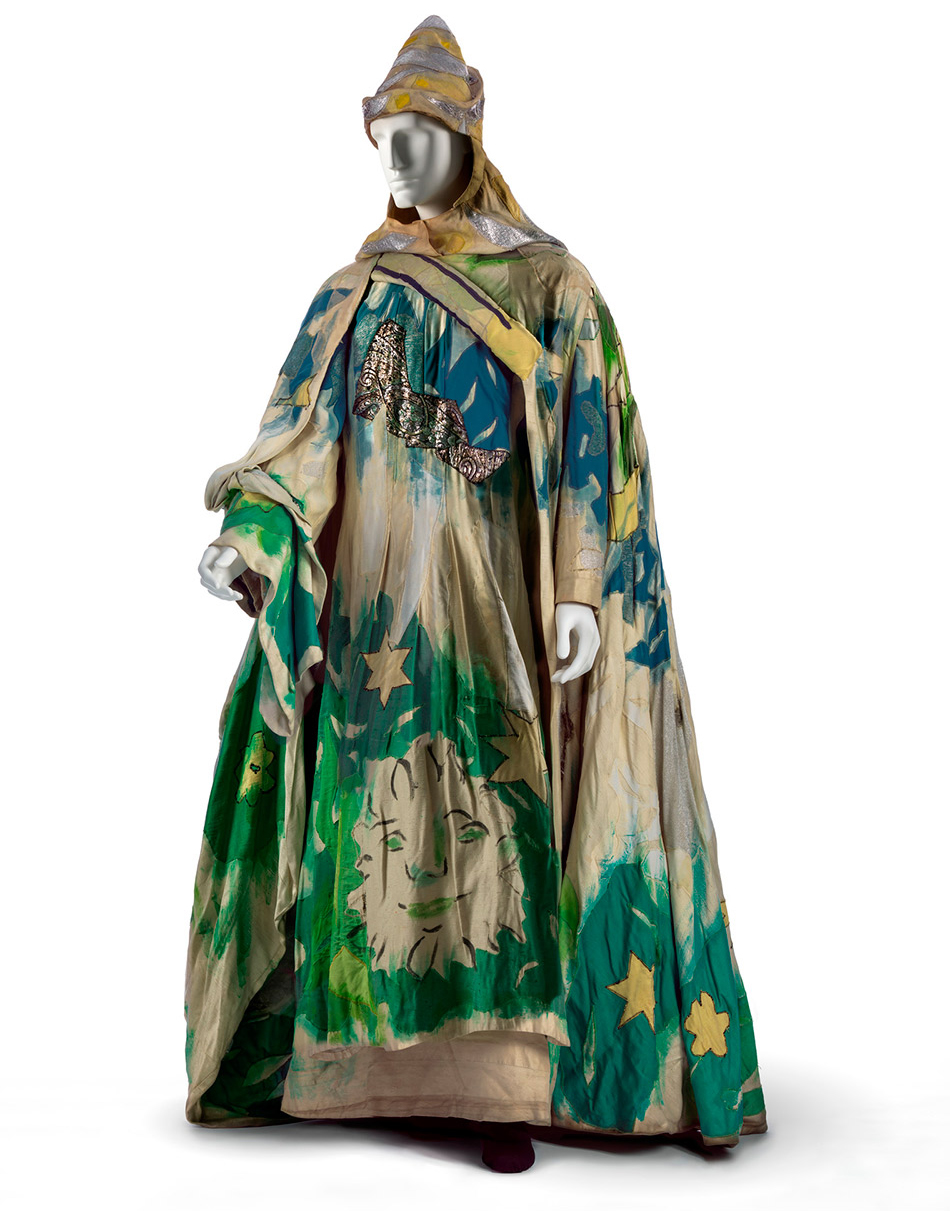
Marc Chagall, Costume for “The Magic Flute: Sarastro”, 1967, silk plain weave, painted, with silk plain weave and metallic appliqués, Metropolitan Opera Archives, New York, © 2017 Artists Rights Society (ARS), New York/ADAGP, Paris, photo © 2017 Museum Associates/LACMA
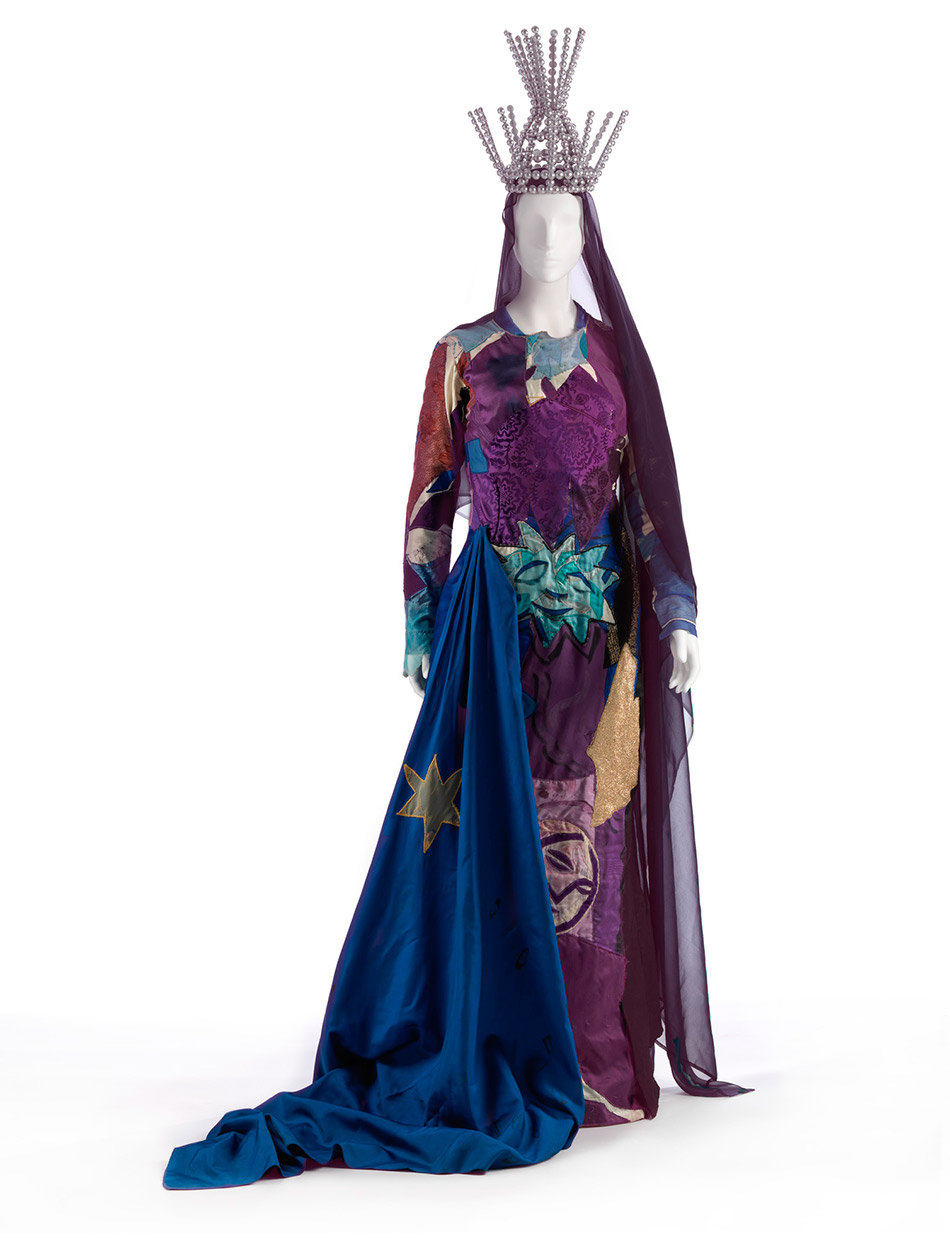 Marc Chagall, Costume for “The Magic Flute: The Queen of the Night” (with Reproduction Headdress), 1967, silk/synthetic plain weave with silk plain weave (chiffon) appliqués, Metropolitan Opera Archives, New York, © 2017 Artists Rights Society (ARS), New York/ADAGP, Paris, photo © 2017 Museum Associates/LACMA
Marc Chagall, Costume for “The Magic Flute: The Queen of the Night” (with Reproduction Headdress), 1967, silk/synthetic plain weave with silk plain weave (chiffon) appliqués, Metropolitan Opera Archives, New York, © 2017 Artists Rights Society (ARS), New York/ADAGP, Paris, photo © 2017 Museum Associates/LACMA
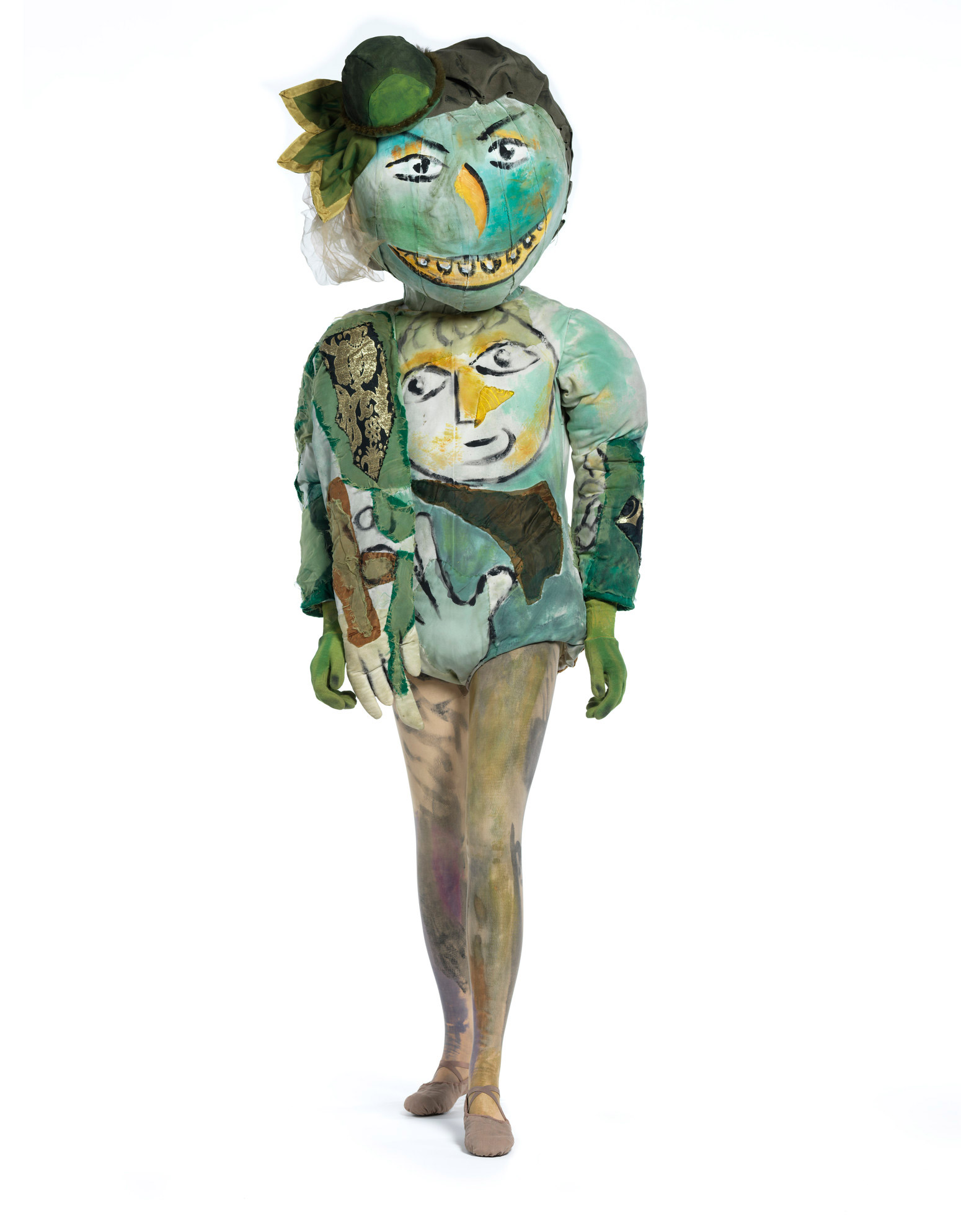 Marc Chagall, Costume for “The Magic Flute: Green-Faced Monster” (with Reproduction Mask), 1967, cotton knit, painted, with synthetic/lurex plain weave appliqués, silk plain weave (chiffon) appliqués, synthetic knit, painted, and papier-mâché, Metropolitan Opera Archives, New York, © 2017 Artists Rights Society (ARS), New York/ADAGP, Paris, photo © 2017 Museum Associates/LACMA
Marc Chagall, Costume for “The Magic Flute: Green-Faced Monster” (with Reproduction Mask), 1967, cotton knit, painted, with synthetic/lurex plain weave appliqués, silk plain weave (chiffon) appliqués, synthetic knit, painted, and papier-mâché, Metropolitan Opera Archives, New York, © 2017 Artists Rights Society (ARS), New York/ADAGP, Paris, photo © 2017 Museum Associates/LACMA
IN ADDITION TO CHAGALL’S STAGE DESIGNS
The exhibition includes a small selection of iconic paintings, many of which are on loan from museums around the world. The works on view include Self-Portrait with Seven Fingers (1912) from the Stedelijk Museum, Amsterdam; Green Violinist (1923–24) from the Guggenheim Museum, New York; The Violinist (1911–14) from the Kunstsammlung Nordrhein-Westfalen, Düsseldorf; and Violinist on a Bench (1920) from LACMA’s permanent collection.
Augmenting the exhibition will be a series of video interviews featuring contemporary artists, costume designers, and opera professionals, selected reviews of Chagall’s productions, and a reading room.
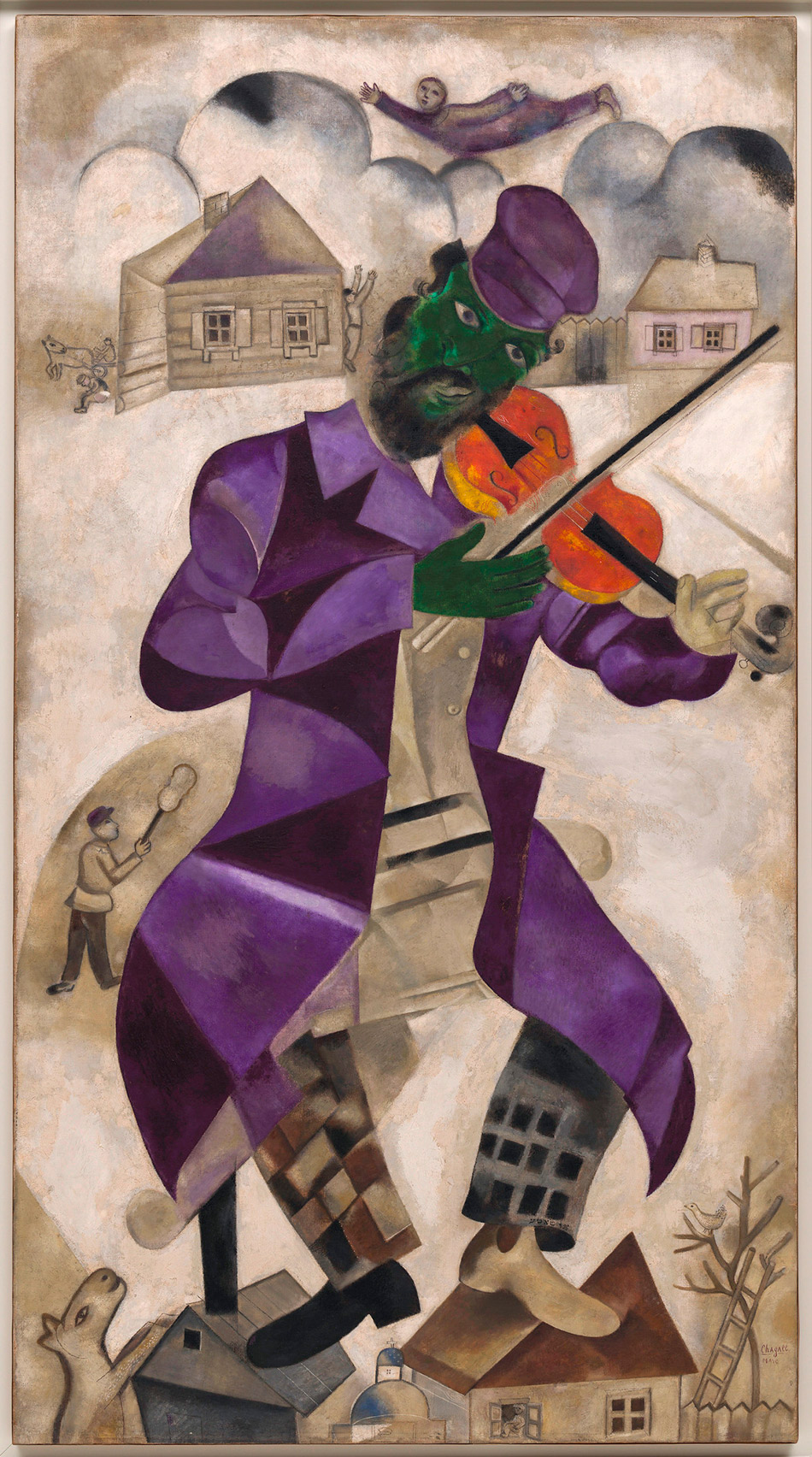 Marc Chagall, “Green Violinist”, 1923–24, oil on canvas, Solomon R. Guggenheim Museum, New York, Founding Collection, by gift, © 2017 Artists Rights Society (ARS), New York/ADAGP, Paris, photo © 2017 The Solomon R. Guggenheim Foundation/Art Resource, NY
Marc Chagall, “Green Violinist”, 1923–24, oil on canvas, Solomon R. Guggenheim Museum, New York, Founding Collection, by gift, © 2017 Artists Rights Society (ARS), New York/ADAGP, Paris, photo © 2017 The Solomon R. Guggenheim Foundation/Art Resource, NY
ABOUT MARC CHAGALL
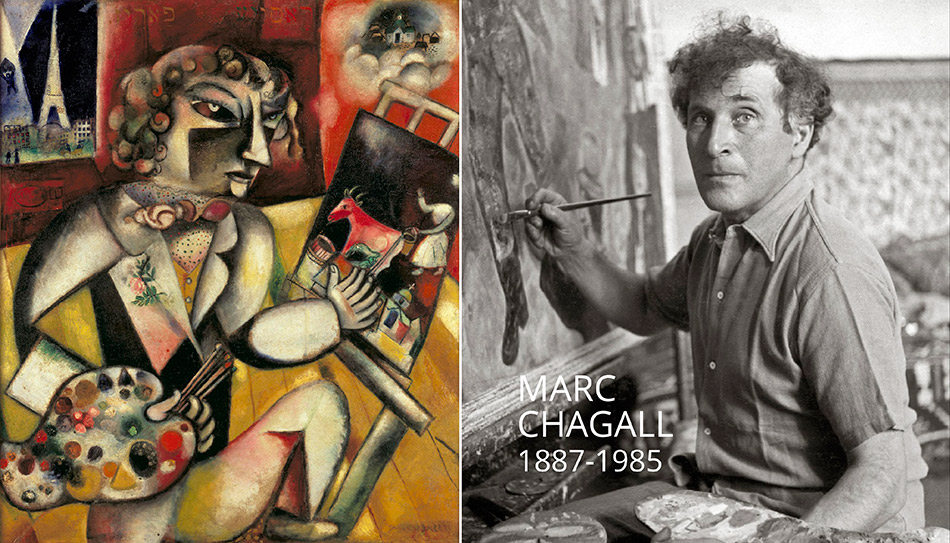
LEFT: Marc Chagall, “Self-Portrait with Seven Fingers”, 1912, oil on canvas, 49 5/8 × 42 5/16 in., Stedelijk Museum, Amsterdam, on loan from the Cultural Heritage Agency of the Netherlands, © 2017 Artists Rights Society (ARS), New York/ADAGP, Paris, photo: Banque d’images, ADAGP/Art Resource, NY
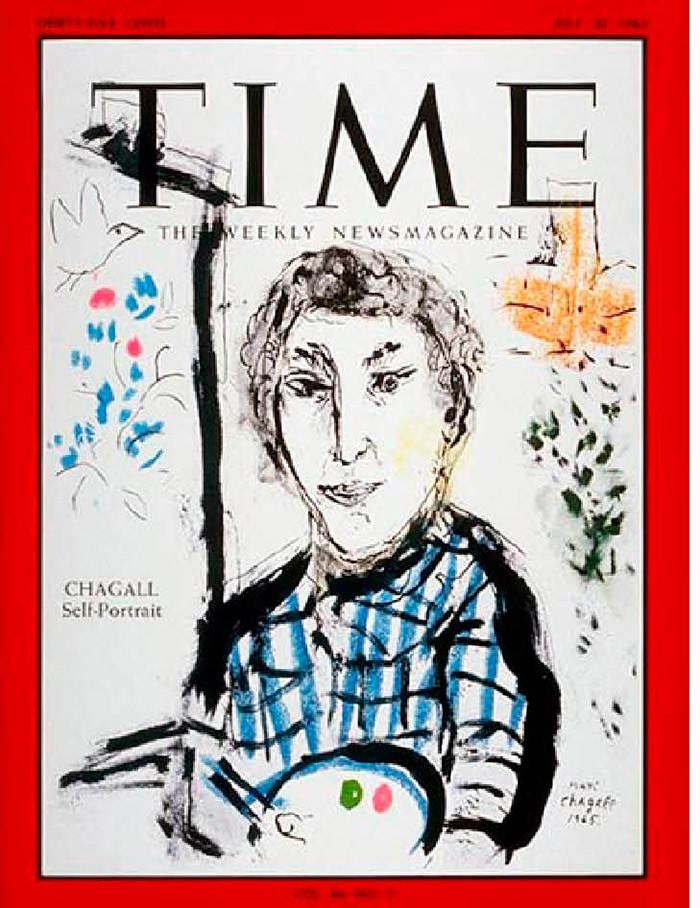
Born in Vitebsk, Russia (present-day Belarus) in 1887, Chagall came to global prominence early in his career, which lasted for more than seven decades and spanned Russia, France, the United States, and Mexico.
Although aspects of Fauvism, Russian Avant-garde, Cubism, Symbolism, and Surrealism are evident in his varied output, Chagall’s lyrical style is uniquely his own.
He remained committed to figurative and narrative art, portraying imagery rooted in personal history, Eastern European folklore, and Jewish and Russian musical traditions.
Given his enduring engagement with the human figure, it is no surprise that Chagall was interested in adapting his work to performance, and saw the stage as a platform for artistic experimentation.
Statements
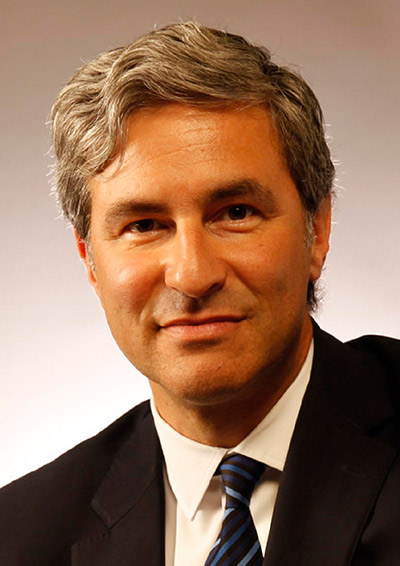
Michael Govan
LACMA CEO and Wallis Annenberg Director
“In bringing together Chagall’s well-known paintings and his innovative theatrical designs, Chagall: Fantasies for the Stage will enhance our understanding of the artist’s expansive body of work.”
“By engaging both the visual and the performing arts, it also fosters a dialogue that reaches across the disciplines of art, music, theater, dance, and even fashion design.”
 Stephanie Barron
Stephanie Barron
Senior curator of modern art
“By focusing on these four productions created during and after his wartime exile in New York, this exhibition brings to the public’s awareness a lesser known but riveting aspect of Chagall’s career, which began in pre-Revolutionary Russia and traversed the breadth of the 20th century.”
“Chagall’s work for the stage is an important early chapter in the history of visual artists who have engaged in similar interdisciplinary collaborations that have immeasurably enriched the history of modern art.”
Organization
Organized by the Montreal Museum of Fine Arts in collaboration with the Los Angeles County
Museum of Art. LACMA’s presentation is organized by Stephanie Barron, together with the museum’s costume and textiles curators.
Design
Opera designer Yuval Sharon and projection designer Jason H. Thompson have created the exhibition design.
Catalogue

Chagall and Music
is the exhibition catalogue for LACMA’s exhibition Chagall: Fantasies for the Stage
Hardcover
392 pages, 9.3 x 11.6 x 1.6 inches
580 color and 20 b&w illustrations
2017
Edited by Ambre Gauthier and Meret Meyer.
SKU: 34616
$50 | Member Price: $45
Available in-store or
online at thelacmastore.org
It explores the profound connection between Chagall and theatre including ballet and opera. As both subject and muse, this relationship has its roots in his family history, and in the Jewish culture of his native city, Vitebsk.
This lavishly illustrated catalogue explores how music functioned as a central theme and inspiration in Chagall’s composition and color, beginning with paintings and sketches in 1911 through the 1960s. Included here are his theatre commissions: the foyer panels for the Jewish Art Theatre (Moscow, 1919-1920), the ceiling of the Paris Opera (1964), and the Metropolitan Opera at Lincoln Center (1966). His designs for the ballet, including Aleko (1942), The Firebird(1945), Daphnis and Chloé (1958) and The Magic Flute (1967), reveal the underlying synergy in his work between music, set, and costume.
A wide selection of paintings, photographs, preparatory sketches, drawings, and ceramics (many from private collections) convey the centrality and importance of music and color in Chagall’s career.
SUPPORT
Initiated by the Cité de la musique – Philharmonie de Paris, and La Piscine – Musée d’art et d’industrie André Diligent, Roubaix, with the support of the Chagall estate.
This exhibition is supported by The Kenneth T. and Eileen L. Norris Foundation, Terry and Lionel Bell, The Jacqueline and Hoyt B. Leisure Costume and Textiles Fund, and the Jewish Community Foundation of Los Angeles.
All exhibitions at LACMA are underwritten by the LACMA Exhibition Fund. Major annual support is provided by Kitzia and Richard Goodman, with generous annual funding from Lauren Beck and Kimberly Steward, the Judy and Bernard Briskin Family Foundation, Louise and Brad Edgerton, Edgerton Foundation, Emily and Teddy Greenspan, Jenna and Jason Grosfeld, The Jerry and Kathleen Grundhofer Foundation, David Schwartz Foundation, Inc., Taslimi Foundation, and Lenore and Richard Wayne.
LACMA. LOS ANGELES COUNTY MUSEUM OF ART
5905 Wilshire Boulevard, Los Angeles, CA 90036 Phone: 323 857-6010 | (TTY: 323 857-0098) lacma.org
 About LACMA
About LACMA
Since its inception in 1965, the Los Angeles County Museum of Art (LACMA) has been devoted to collecting works of art that span both history and geography, in addition to representing Los Angeles’s uniquely diverse population.
Today LACMA is the largest art museum in the western United States, with a collection that includes more than 130,000 objects dating from antiquity to the present, encompassing the geographic world and nearly the entire history of art.
Among the museum’s strengths are its holdings of Asian art; Latin American art, ranging from masterpieces from the Ancient Americas to works by leading modern and contemporary artists; and Islamic art, of which LACMA hosts one of the most significant collections in the world. A museum of international stature as well as a vital part of Southern California,
LACMA shares its vast collections through exhibitions, public programs, and research facilities that attract over one million visitors annually, in addition to serving millions through digital initiatives such as online collections, scholarly catalogues, and interactive engagement. LACMA is located in Hancock Park, 30 acres situated at the center of Los Angeles, which also contains the La Brea Tar Pits and Museum and the forthcoming Academy Museum of Motion Pictures. Situated halfway between the ocean and downtown, LACMA is at the heart of Los Angeles.